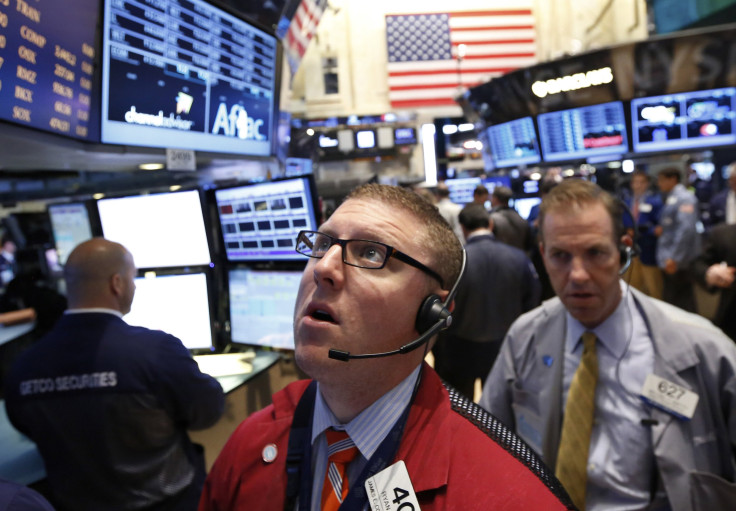Dow Plunges 354 Points In Global Stock Sell-off After Federal Reserve Chairman Ben Bernanke’s Remarks Post-FOMC Meeting; Treasury Yields Soar To Two-Year High

UPDATE -- 4:45 p.m. EDT: The Dow Jones Industrial Average plunged 354 points Thursday as investors, panicked over prospects that the Federal Reserve will reduce its unprecedented money printing, thus potentially pulling the rug out from under global equity markets, scrambled to unload their holdings. Gold in New York trading closed down nearly 7 percent, and the yield on benchmark 10-year Treasury yields soared nearly 5 percent to two-year highs.
Investors on every continent sold off a broad array of assets because on Wednesday when the Federal Open Market Committee (FOMC) of the Federal Reserve concluded a two-day meeting by issuing a surprisingly optimistic outlook for U.S. unemployment, and Chairman Ben Bernanke said later in a news conference the Fed could start reducing its $85 billion monthly bond purchases later this year because of the strengthening economy.
Those bond purchases, known as quantitative easing, have the direct effect of expanding the money supply, and much of that newly minted money goes into financial securities like stocks. The upshot has been an increasingly large amount of money chasing a fixed number of investments and a resulting surge in the price of stocks. From June 26, 2012, to May 22, 2013, the S&P 500 jumped 29 percent. Quantitative easing also has driven down the yield on bonds to historic low levels and, because bond prices and yields move in opposite directions, boosted bond prices into what some have worried is a bond bubble.
Prospects of declining monetary support from the Fed is panicking stock investors who anticipate less demand for their equities if the Fed stops printing as much money. It also panicks bond investors who for the same reason anticipate rising yields and, thus, falling bond prices.
In the U.S., the blue-chip Dow dropped 354 points, or 2.34 percent, to 14,758.32, well below the psychologically significant 15,000 level. The other two main U.S. stock indices also took big hits: in late afternoon trading the Nasdaq 100 closed down 2.28 percent and the S&P 500 gave up 2.5 percent. Yields on 10-year U.S. Treasury notes jumped 4.67 percent as the price tumbled for the second consecutive day.
Because of globalization the effects of the Fed pulling back its support of the markets ensures worldwide consequences. Germany DAX fell 3.66 percent, France's CAC 40 was off 3.28 percent and the U.K.'s FTSE 100 dropped 2.83 percent. In Asia losses were nearly as bad: Japan's Nikkei 225 index tumbled 1.74 percent, Singapore's Straits Times index plunged 2.51 percent and Hong Kong's Hang Seng index gave up 2.88 percent.
Gold prices fell nearly 7 percent, falling below $1,300 for the first time since September 2010. The price of crude oil dropped nearly 4 percent to about $93 per barrel.
The Fed's decision to start signaling an end of monetary accommodation could indicate a sense that its initatives have reached the point of diminishing returns.
"I think of the Fed's action as capitulation," said Steven Blitz, ITG's chief economist. "They recognize they have done as much as they can do to improve the economy in the equity markets. There is nothing left for them to do."
Blitz also sees the process of getting interest rates back to normal levels as taking three or four years, a period during which the severity of Europe's economic problems, the "slow implosion of economic activity in China" and the effect of those two factors on the emerging markets could extend the process even longer.
The sheer size of the market's collapse Thursday augurs more of the same on Friday. A Dow close Thursday below the key technical support level of 14,825 could provide sustenance for market bears, who have argued that the Dow is overvalued, with rises in 2013 propelled mostly by the federal reserve’s quantitative easing.
"There's money leaving the market from people who were convinced that the rally has been mostly attributable to the Fed, and the rise on the 10-year yield is a concern since it happened so quickly," David Joy, chief market strategist for Ameriprise Financial in Boston, told Reuters. "It's too early to say whether this represents a buying opportunity or if the weakness will continue."
Beyond this week and this month, analysts see opportunities. Blitz suggests looking at industrials, many of whose share prices look like they will be supported by earnings growth instead of stock buybacks and dividends.
"Nothing fundamentally has changed in the U.S. economy between yesterday and today. What's changed is a perception about what's coming next. There's a dose of reality about growth for the rest of the year," said Blitz. "But once everyone adjusts to this reality people will see that individual stocks have dropped to an attractive level, and you use that as an opportunity to pick a spot."
© Copyright IBTimes 2025. All rights reserved.






















